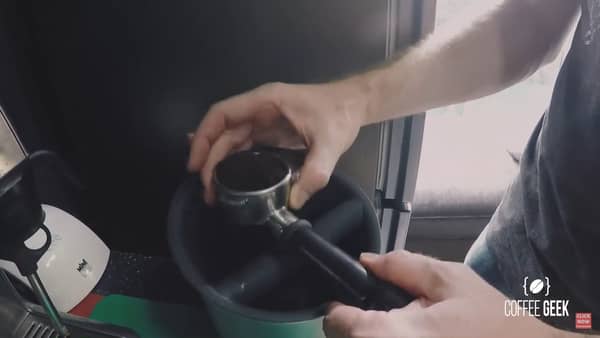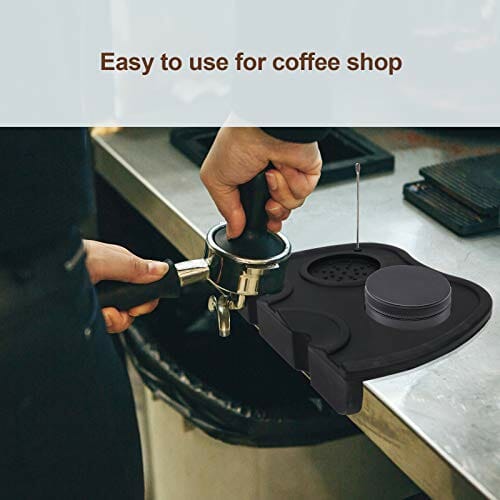If you’re not satisfied with your espresso shot despite making sure that you’ve got the coffee grounds right in every way (bean, roast, grind, and amount), you may be missing out on one more crucial element to pulling the perfect espresso shots.
The title should clarify this already: Tamping technique!
In this article, I will show you why you need to learn how to tamp coffee properly including a few tips on how to tamp to master brewing espresso on your next try.
What Is Tamping Coffee?
Tamping is the act of compressing and flattening a coffee bed into a more compact and much denser coffee puck.
It’s a method commonly found in making espresso, which involves the coffee grounds being tamped in the portafilter basket of the espresso machine.
Should You Tamp Your Coffee?
Now, does tamping make a difference? What is the purpose of tamping coffee?
Yes, and hear me out.
Let me remind you of the basics of making a great espresso. You need to run hot water under high water pressure through the grounds to extract a small amount of concentrated coffee with bold flavor and rich texture.
So turning the loose grounds into a compressed puck-shape bed by tamping eliminates loose spots and, in turn, makes espresso distribution denser.
Since water will flow through the gaps where there’s the least resistance, the tamped bed of coffee causes the gaps to become smaller, making it harder for water to push through without any amount of pressure.
And that’s where pressurized water comes into play. As the water is shot through the bed of coffee under very high pressure, it effectively pulls along the coffee oils commonly found in dark-roasted coffee beans. This results in extraction with a bold taste and a full body. So…
What Happens If You Don’t Tamp Espresso?
What can happen is a weak and uneven extraction of flavor due to a loose and uneven distribution of coffee grounds.
Since the grounds aren’t as compact, water can make its way through easier and faster, leading to under-extraction.
Some might argue that their espresso shots still come out just fine, if not great, despite not tamping from their personal experience.
This is likely because their grounds distribution is already relatively even thanks to practice.
And, when they lock the group handle into the brew head, the dispersion screen help “tamp” the bed to become more reasonably uniform and dense. So the resulting espresso brew can still taste and feel amazing.
So, do you have to tamp coffee? Is tamping necessary? Can you skip it when you don’t feel like it?
Well, depending on who you ask, each barista may give you a different answer. The bottom line is consistency in brewing ingredients and techniques, including tamping, to produce consistently good espresso for your personal taste.
As a coffee aficionado, here are my two cents:
Although tamping isn’t among the top crucial factors that impact the extracting flavor, it still makes a difference in shaping the grounds into a more uniformly tight bed, which can result in a more even extraction.
Especially as a beginner home brewer, going the extra mile is always the better call.
What Can I Use To Tamp My Coffee?
Usually, your espresso machine should come with an espresso tamper that’s specifically designed for the job.
It looks pretty similar to a stamping device with a clean flat surface at the bottom and a neat handle on the other side.
What Makes A Good Coffee Tamper?
The tamper can come in various shapes, sizes, weights, materials, and designs, which can affect its compatibility with your portafilter and you.
If you’re looking for one, visit my article on the best espresso tampers which also includes a buyer’s guide to picking out yours!
What To Do If You Don’t Have A Tamper?
Lost or broke your tamper? Traveling and brewing with a portable espresso maker? Just want to give tamping a try to see how the output is different from your usual routines and therefore don’t want to commit to a brand new one? I’ve got you covered.
You can use anything with a flat and even surface that can fit into your portafilter to do the job. Think the bottom of a bottle or a glass, a spoon, a hammer, etc.
They won’t be as easy to handle and create a good espresso puck as a real tamper, but when push comes to shove, they’ll have to do.
Do You Need A CoffeeTamping Mat?
The small tips under the portafilter can be quite ruthless and even bottomless portafilters can cause damages to your counter or workspace over prolonged usage due to the tamping pressure.
So, if you don’t want to ruin your counter, get a tamping mat to accompany each tamping endeavor.
Another reason why you should get a mat is it provides a more stable non-budging foundation.
This can significantly improve the tamping pressure and the overall quality of the tamp and reduce the risk of straining your wrist, though repetitive strain injuries are more common among professional baristas who make more than a single shot a day.
Is A Knock Box Necessary?
What is the point of a knock box for espresso? Baristas everywhere use it as a convenient bin to dispose of used and excess ground coffee.
Knocking the portafilter to dump the grinds directly into a trash can or sink can be unsanitary, clog your sink, and damage your portafilter.
So the knock box was designed as a convenient bin to store your used and excess grinds, which later on can be repurposed as baking ingredients, fertilizers, etc.
So, do you really need a knock box? No, but my goodness, doesn’t it help?
What Is The Proper Way To Tamper Coffee?
Step 1: Add Coffee Grounds
Make sure the portafilter is dry and clean before adding the measured coffee grounds.
There are different types of coffee grinders.
Some may allow you to grind directly into the filter basket.
Others dispense it into a brewing basket, so you have to add it manually afterward.
What matters the most is getting consistent grounds in the right grind size, which can only be achieved with a quality grinder.
Step 2: Even Out The Coffee Bed
You’ll see that the ground bed is mounding over the portafilter, especially if you up-dose, which means adding a bit more coffee so that you’d get the right amount after evening out and tamping the bed.
Before tamping, I recommend giving the portafilter a couple of gentle whacks on the handle against the bar of the knock box. You can also give it a couple more taps on the mat to remove some excess grinds.
Then slide your index finger across the top of the portafilter twice in opposite directions to even out the coffee. Use your finger to wipe off any loose grinds sticking to the portafilter.
Finally, place the portafilter on a level surface, *cough* tamping mat *cough*, ready for action.
Step 3: Hold Your Tamper
How do you hold a tamper?
Make sure to keep your wrist straight and elbow bent at a 90-degree angle to use your body’s power rather than your wrist alone, ensuring an even-handed pressure.
Then hold the handle between your thumb and your index finger and have the tamper rest level on the bed of coffee.
Step 4: Tamp The Ground Coffee
Lean forward with your bodyweight to give it a little bit of a squeeze at first, a light amount of around 15 lbs of tamping pressure to form an even bed to start with.
Next, give a stronger press to apply a firm and consistent pressure of 30 lbs to create a tightly compressed and level bed. As you’re leaning back up, give a downward twist to make sure the tamp stays.
So, how do you know how much pressure you’re putting in?
If you don’t have a calibrated tamper that can show you the amount of pressure, you can practice while standing on a bathroom scale and see how much weight decreases when you’re pressing down, which should be an indicator of your tamp pressure.
And, what happens if you tamp coffee too hard? Over-tamping can lead to over-extracted espresso due to a slower flow rate. So under-extraction isn’t the only thing you should mind.
Step 5: Polish Your Tamp (Optional)
You can give it a final twist of the tamper to “polish” the outcome and ensure that there’s 0 chance of an uneven tamp.
To Wrap Up How to Tamp Coffee
Gather the tools and practice each time you pull a shot to perfect your pressure control and it’ll become your second nature before you know it.













